Lisbon, the capital of Portugal is soaked in history and teems with alive culture. Found along the Tagus River, this attractive city includes traditional charm together with modern attractions. Its trams that move through narrow streets to the magnificent views at its many viewpoints referred to as miradouros are just some of the things which give an unusual air about Lisbon.
The town is recognized for having a great number of Gothic cathedrals, majestic monasteries and buildings decorated with tiles that have different colours. Whether you’re exploring historic areas like Alfama or Bairro Alto, enjoying Portuguese cuisine such as seafood dishes cooked with olive oil sauce served alongside mashed potatoes mixed up flavoured cream cheese or experiencing lively nightlife – there isn’t anything else but various activities in this place suited for any type of traveler’s interest.
Map
Belem Tower
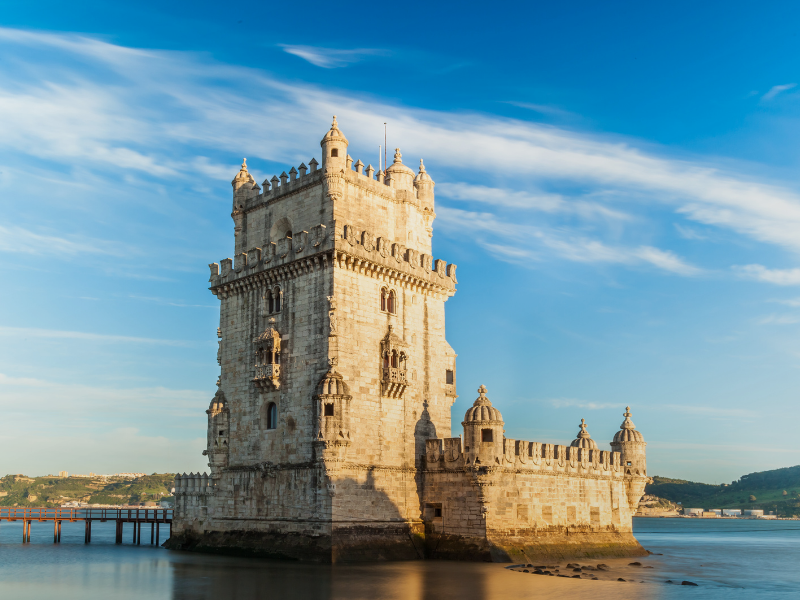
Torre de Belém or Belem Tower stands majestically at the mouth of the River Tagus in Lisbon, Portugal. This UNESCO World Heritage Site not only speaks to an impressive illustration of Portuguese Manueline architectural style, but also a symbol of Age of Discoveries when Portugal stood out as leader in sea exploration. Originally built for military purposes and to better mark the entrance gateway to Lisbon around early 1500s and it is presently the most photographed monument in Lisbon due to its historical richness.
Belem Tower was commissioned by King Manuel I and completed under his reign, from 1515 – 1521, with an idea that it would safeguard Lisbon as well as serve as ceremonial portal into its main city. It formed part of a defense system along the Tagus Estuary and a gateway through which one entered into Lisbon. The construction took place during the peak period in Portuguese Renaissance when there were colonial empires established across Europe. It is designed with features influenced by Moorish Gothic, Manueline architectural styles demonstrating Portugal’s rich taste for luxury.
This tower has undergone various transformations since its inception such serving as customs and telegraph post rendering it even into lighthouse. It commemorates the period of discoveries and is a symbolic monument to Portugal’s maritime prowess that led to exchange with other cultures as well as wealth accumulation for Europe therefore making Portugal one of the superpowers in 16th century.
Nearby Attractions
- Jerónimos Monastery: Vasco da Gama was buried here and this monastery which can be visited on foot from the tower, another tribute to Manueline architecture.
- Monument of Discoveries: A modern monument stands near it showing how Portuguese explorers have influenced this site by giving tourists yet another chance to view River Tagus better.
Jeronimos Monastery
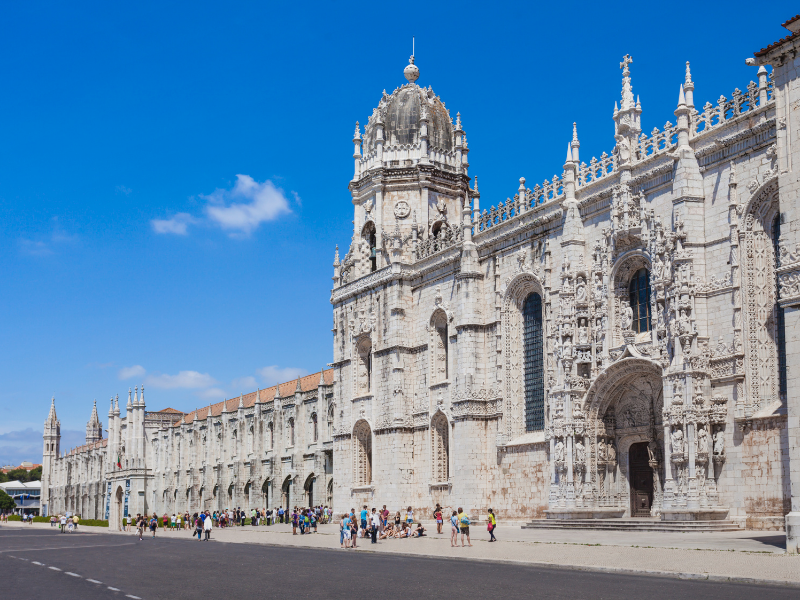
Jerónimos Monastery (Mosteiro dos Jerónimos) is a monument that locates in the historical district of Belém, Lisbon. This UNESCO World Heritage site is famous for its splendid Manueline architecture and stands as a great example of the maritime explorations that led to the discovery of India, Africa, and Brazil. The monastery was constructed in 16th century during King Manuel I’s reign. It is important not only in Portuguese history but also demonstrates how rich Lisbon’s culture is.
Jerónimos Monastery started being built in 1501 and was completed after a century. This money came from the wealth flowing into Portugal through new trade routes especially spices and gold from Africa and Asia. The monastery stands on which Vasco da Gama spent his last night by Portuguese before starting his journey to India thus connecting it with the era of maritime adventures that characterized Portugal’s history.
In 1907, Jerónimos Monastery was declared a national monument and in 1983 UNESCO World Heritage Site which indicates that its significance transcends Portugal. Presently, it serves as an essential educational resource on Portugal’s unique historical and architectural heritage while providing cultural events such as exhibitions, concerts among others.
Nearby Attractions
- Discoveries Monument: This nearby attraction is dedicated to the navigators who influenced Portugal’s Age of Discoveries.
- Belém Cultural Center: A modern cultural complex that offers a range of exhibitions and performances, and also houses the Berardo Museum of Modern and Contemporary Art.
Alfama
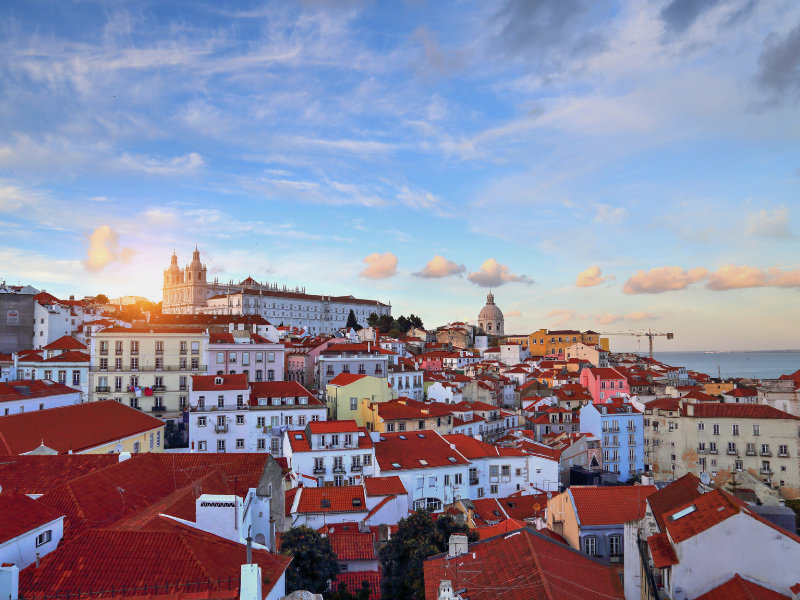
Alfama, the oldest district in Lisbon, is like a travel back in time. It is a picturesque quarter where narrow winding roads are found while old structures still cling to the hillside under the huge São Jorge Castle. In addition to its historical architecture, this scenic district is also known for its vibrant Fado music scene that makes it a cultural experience for tourists.
Alfama’s history is intimately tied up with that of Lisbon. After surviving the great earthquake of 1755 which almost flattened the city, Alfama remains as a window into the past and some constructions date back to Moorish era when Muslims occupied Lisbon. Once considered as a poor neighborhood inhabited by fishermen and factory workers, it has now become famous for preserving Portuguese traditional values and buildings.
Architectural Highlights
São Jorge Castle: The medieval castle offers stunning views over Lisbon and takes you on a journey through Portugal’s history.
Sé Cathedral: This imposing cathedral blend of architectural styles shows how its rich history was influenced by different cultures; it is located just few minutes walk away from Alfama’s heart.
Cultural Experiences
Fado Houses: Birthplace of Fado, which is Portugal’s haunting traditional music form; you can’t leave Alfama without experiencing live Fado performance from any local taverns within.
Feira da Ladra: A renown flea market held every Tuesdays and Saturdays where you will find antiques, handmade crafts or anything else you may imagine.
Local Life and Traditions
Explore labyrinthine streets: Meandering through narrow alleys of Alfama gives one an intimate look at delightful colorful homes, mom-and-pop stores selling traditional goods as well as charming little cafes that define this area.
Enjoy local cuisine: Throughout Alfama there are small family restaurants where one can sample typical Portuguese dishes; these places reflect the spirit of locality in their authentic foodstuff.
Nearby Attractions
- National Pantheon: For anyone keen on history, it’s a must-see place as it hosts tombs of significant Portuguese personalities.
- Miradouro de Santa Luzia: Lisbon’s one of the best viewpoints is a perfect spot for taking panoramic shots over Tagus River and the city.
São Jorge Castle

Sitting atop the highest hill in Lisbon, São Jorge Castle (Castelo de São Jorge) not only offers panoramic views over the red-top terracotta roofs of the city but also takes you through layers of Lisbon’s rich history. A key landmark in the city, it has been visible from almost everywhere reminding onlookers about times before Portuguese people came here.
The history of São Jorge Castle stretches back over a millennium back to the Romans who built first fortifications around 1st century B.C. It was later fortified by Visigoths in 5th century and then converted into a Moorish royal residence during Umayyad conquest of Iberian Peninsula in 8th century. The Reconquista period saw its capture and transformation into a royal palace for Portuguese Monarchy under its conqueror King Afonso Henriques in 1147.
São Jorge Castle is not just an architectural wonder; it’s also a cultural landmark. In fact, within the castle there is a permanent exhibition that showcases its historical significance through archaeological relics found within Lagos and beyond. These artifacts have revealed much about Lisbon’s past from as far back as 700 B.C to when Portugal was ruled by the monarchy (18th century).
Nearby Attractions
- Alfama District: Just below the castle, Alfama district is known for its narrow medieval streets, traditional Fado houses and lively local lifestyle.
- Miradouro de Santa Luzia: This viewpoint near the castle provides one of best views on Lisbon which are perfect for taking some pictures or just looking at stunning panorama above city.
Lisbon Oceanarium
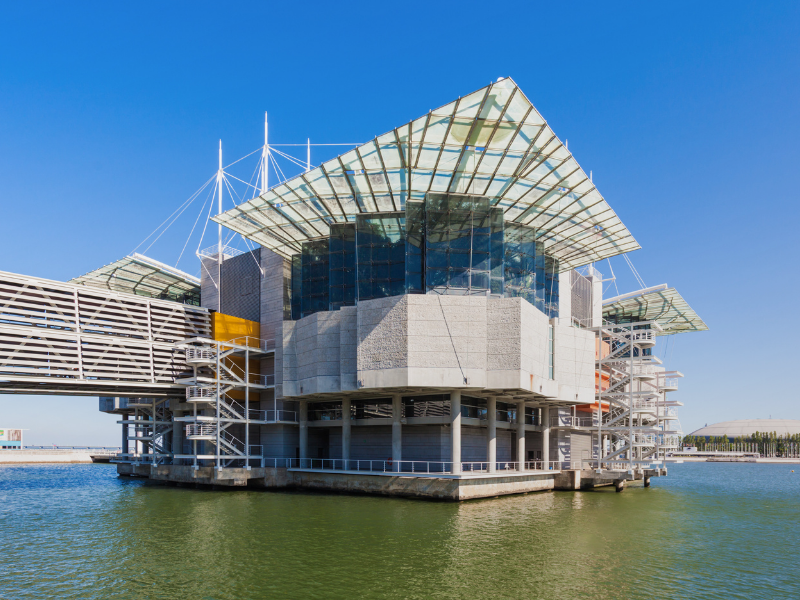
Situated in the contemporary Parque das Nações neighborhood, Lisbon Oceanarium is one of the biggest and most innovative aquariums in Europe. Completed by Peter Chermayeff, who is an American architect, and opened during Expo ‘98 World Exposition in 1998, it has become a leading light of marine preservation and education. This exciting attraction takes visitors into the rich oceanic environs of the world and thus a must visit to families, marine enthusiasts and anyone who loves beauty as well as variety represented by fish life.
Equally striking as its contents is the architectural design of Oceanarium which features a huge central tank surrounded by four smaller tanks representing different global marine habitats including North Atlantic rocky coast; Antarctic coastline; Temperate Pacific kelp forests; Tropical Indian coral reefs. This arrangement ensures that tourists experience a continual journey through diverse marine ecosystems.
Nearby Attractions
- Cable Cars: Take a trip on cable cars outside Lisbon Oceanarium for breathtaking views over River Tagus and Vasco da Gama Bridge
- Pavilion of Knowledge: A nearby center for interactive science exhibits with interesting displays mainly for children and their parents.
Praça do Comércio
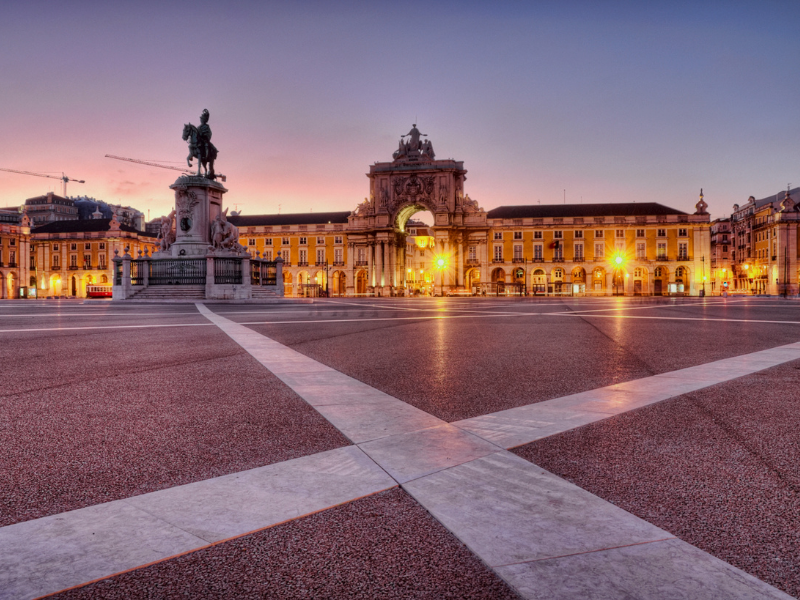
A lot of landmarks are found in Lisbon, but none is as iconic as Praça do Comércio. Terreiro do Paço, as it is also called, is not just a scenic spot but a symbol of Lisbon’s indomitable spirit and link to its vibrant history.
Praça do Comércio is located by the Tagus River which used to be the site of Royal Ribeira Palace before it was destroyed in 1755 earthquake. The square was rebuilt meticulously during Pombaline downtown (Baixa) reconstruction exercise under Marquis of Pombal has vast open spaces with elegant arcades reflecting the neoclassical style that signalize rejuvenation and architectural skillfulness of Lisbon.
One of the most remarkable features at Praça do Comércio is Arco da Rua Augusta, a triumphal arch marking grand entrance into the square through Rua Augusta. It was constructed in 1873 and decorated with statues of historical personalities such as Vasco da Gama and Marquis de Pombal among others. It offers breathtaking view over the square and river.
The equestrian statue Joaquim Machado de Castro sculpted King José I that stands at the center commemorates strength and leadership signified by king on horseback; it remains popular among tourists.
Nearby Attractions
If you are visiting Lisbon for sight-seeing purposes there are many things you can start your day from Santa Justa Lift at Praça do Comercio. A few minutes’ walk away lies Alfama that is characterized by narrow streets, Fado Music, plus old world charm. At close proximity stand Sao Jorge Castle (Castelo de Sao Jorge), The Lisbon Cathedral (Sé de Lisboa) besides historic tram 28 route that take people back to ancient times.
Rossio Square
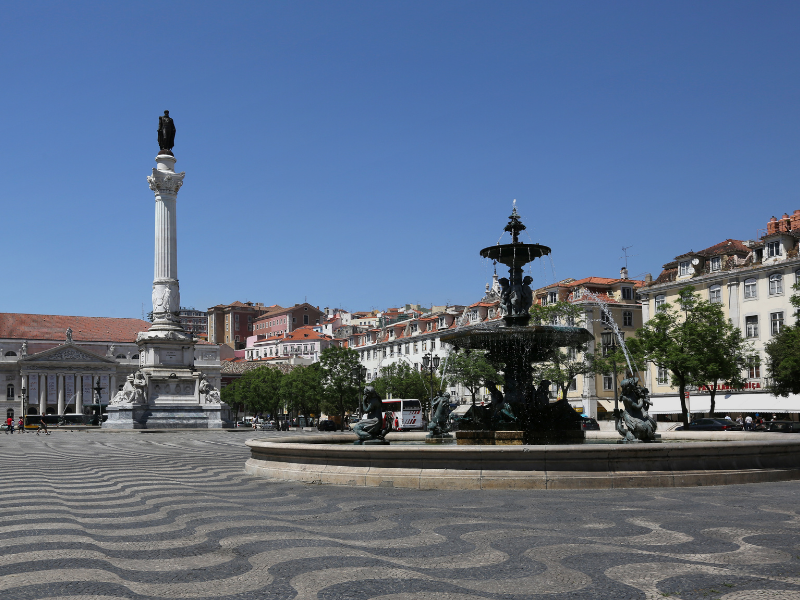
Rossio Square is among the most popular squares in Lisbon. Located in Pombaline Downtown, it has been a meeting point for locals and foreigners dating back to many centuries ago. It is one of those places in Lisbon that people must visit because of its rich past, beautiful architecture and lively ambiance.
Rossio Square has a long history that dates back to the Middle Ages. It has witnessed numerous historical events such as celebrations, festivals, revolutions and public executions. The square was named after the King of Portugal, Pedro IV with his statue positioned centrally symbolizing the importance of him in the country.
After the devastating earthquake of 1755, Rossio Square was reconstructed which gave rise to Pombaline architectural style in Portugal. A good example of this type of architectural design is seen from the pavement’s beautifully laid wave-like cobblestone patterns called “calçada Portuguesa.”
One feature that makes Rossio Square remarkable is its Dom Pedro IV Statue built in 1870. Standing on top of a high pole, it depicts a king wearing royal garments holding constitution. Also around the column are four allegorical figures representing Justice, Wisdom, Strength and Moderation.
The two outstanding fountains were brought over from France during the nineteenth century; they give an added touch of grace to square making it excellent place for some relaxation or photo shoot opportunities.
On North side lies National Theatre D.Maria II named after Queen Maria II who was ruling during this time period. This cultural center boasts grand porticoes with Corinthian columns and it stages performances such as plays , concerts and operas amongst others.
Nearby Attractions
Rossio Square is conveniently placed if you want to explore other famous sights within walking distance. Alfama area known for narrow streets lined by houses stands close by where traditional Fado music can be heard occasionally. Another site worth visiting here would be Carmo Convent with gothic ruins signifying Lisbon’s past.
Bairro Alto
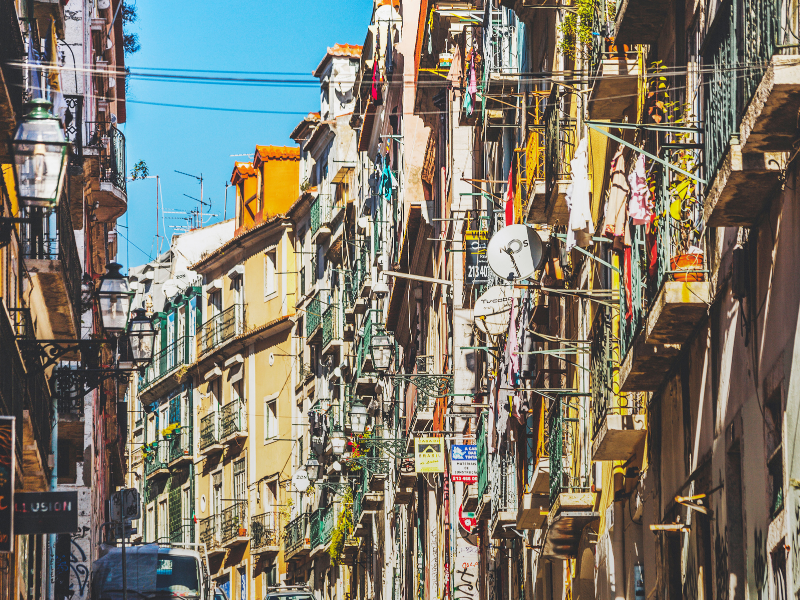
Bairro Alto is located on top of one of the steepest hills in Lisbon City. In daytime, it’s calm and peaceful while at night, the neighborhood becomes vibrant. The streets are cobbled and lined with picturesque buildings that have made this place the bohemian heart of Lisbon from where artists, writers, and culture lovers get attracted.
In the 16th century when Lisbon was starting to expand Bairro alto was founded. It existed as an elite residential area for wealthy merchants from Lisbon but with time changed into a commercial hub combined with bohemia. Nowadays it still retains its historical background through architecture and traditional shops.
Cultural Fusion
Art & Galleries: There are various contemporary art galleries in Bairro Alto that showcases works by both Portuguese and international artists which show how this place has been continuing its artistic journey.
Theatre & Music: Performances abound in Bairro Alto which boasts several small theatres hosting live music shows especially Fado music Portugal’s soulful traditional genre.
Nightlife
Bars & Restaurants: Once darkness falls over Bairro Alto, you can find various bars, restaurants or Fado houses playing music loudly into the streets. This is definitely among the best places to enjoy Lisbons legendary nightlife!
Rooftop Lounges: Some buildings have rooftop bars and terraces where you can sip a cocktail beneath the stars whilst having stunning panoramic views of Lisbon below.
Shopping
Unique Boutiques: During daylight hours you can explore these shops dealing in vintage clothes up to independent fashion through artisan crafts onto quirky souvenirs.
Nearby Attractions
- Miradouro de São Pedro de Alcântara: Take pictures or have some quiet moments on this garden terrace bearing panoramic views of a cityscape.
- Chiado: Downhill from Bairro Alto next to upscale neighbourhoods with refined shopping says more than Lusa do Avenida cultural sites such as museums including Madre Deus church or even cafes.
LX Factory
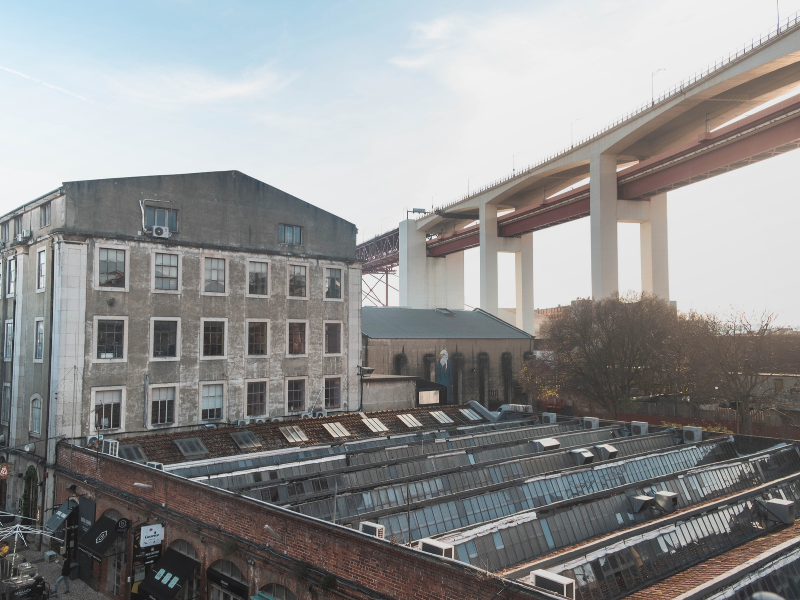
LX Factory, situated in Alcântara district, below 25 de Abril Bridge is one of the most lively and artistic places in Lisbon. LX factory was a big industrial complex but has been converted into cultural and art center with unique mix of shops, restaurants, galleries and event venues that attract both local residents and tourists.
Its roots date back to 1846 when it started as a textile factory. For many years this place has been home to different manufacturing activities until its transformation into an art village in 2008. With its red brick buildings and tall chimneys, the preserved industrial architecture creates a unique backdrop that celebrates both the past and the present times.
Wandering around LX Factory feels like entering another world. The narrow streets are like a labyrinth with hidden courtyards which always have something new to discover at every turn. There is so much street art around too; hence the reason why it’s known as one of the creative hubs in Europe.
Unique Shops and Boutiques: There are several independent shops on LX Factory. You can get vintage clothes or handcrafted jewelry; cool stuff for your house or some unusual souvenirs which are fit for all ages. A tiny bookshop called Ler Devagar caught my eye because it had books from floor to ceiling, even had a hanging bicycle as part of its display.
Art Galleries and Studios: On LX Factory premises there are various artist galleries and studios featuring contemporary works by artists from Portugal as well as other countries globally. I enjoyed watching those amazing installations by artists while they were carrying out their projects.
Culinary Delights: The food scene at LX Factory is diverse and vibrant. There is such variety here from trendy cafes to fancy restaurants plus also food trucks serving international cuisine that food lovers will be spoilt for choice here! I remember going to Cantina where I had an amazing traditional Portuguese meal but with modern twist. While visiting Lisbon, one must also make sure that they visit Landeau Chocolate and taste the best chocolate cake in Lisbon.
Events and Workshops: LX Factory has a number of events that take place all year round such as craft markets, music concerts, yoga classes etc. During my visit there was a weekend market for local artisans and even live performances of music which added to the general buzz that surrounded this place.
Nearby Attractions
After exploring LX Factory, you can walk by the river to MAAT-Museum of Art, Architecture and Technology which is housed in an amazing modern building. Also near are Belem district where you can find famous bakery Pastéis de Belém as well as historical landmarks like Jerónimos Monastery and Belem Tower.
Lisbon Cathedral
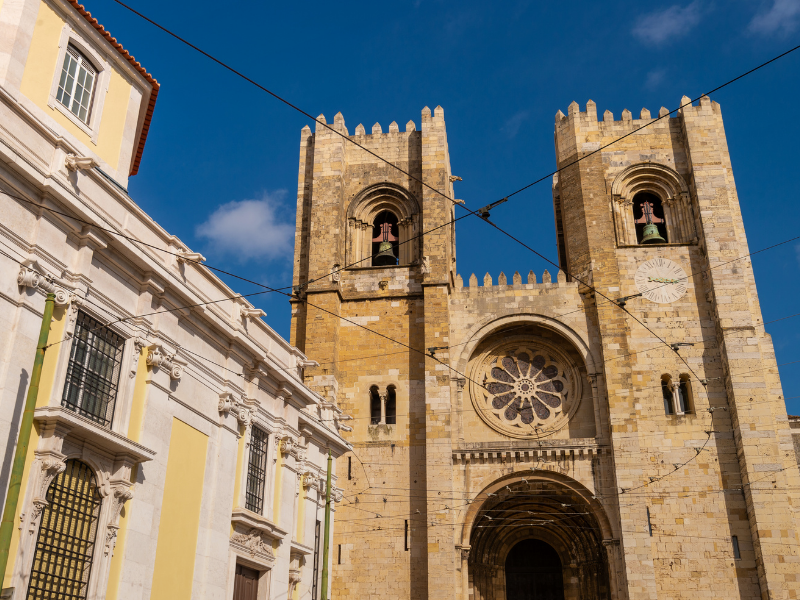
Lisbon Cathedral is one of the most famous buildings in Lisbon, and its history can be traced back to ancient times. It was built between 1147 and 1200 by the Portuguese Christian King Afonso I after taking over Lisbon from the Moors. From that time till now, a number of changes have been made to it and many other restorations following various architectural styles such as Romanesque, Gothic and Baroque.
The cathedral’s façade has a fortress-like look that you will notice even before you reach there. The two tall towers and walls with battlements give it an authoritative appearance. The rose window above the entrance is remarkable because of its elegant stonework which enhances the grandiosity of this church.
When you go inside, you will be impressed by towering stone pillars along with high vaulted ceilings which are typical for Romanesque architecture. In addition, there are numerous chapels with religious paintings as well as intricate carvings on them in the ambulatory that dates back to the 13th century when it was built.
There is one part of this building that stands out among all others for its diversity in culture: its cloister area still contains remnants of Roman, Visigothic and Moorish structures as uncovered during archaeological excavations undertaken here. This shows how deep-rooted it is within Lisbon’s history.
Nearby Attractions
Located at Alfama district where starts narrow streets full of twist and turns; therefore, this makes Lisbon Cathedral an excellent place to begin exploring nearby. Also located not far away is São Jorge Castle – another historical spot with breathtaking views over the city; followed by Fado Museum plus Church St Anthony next door dedicated to Lisbon’s patron saint.
Santa Justa Lift
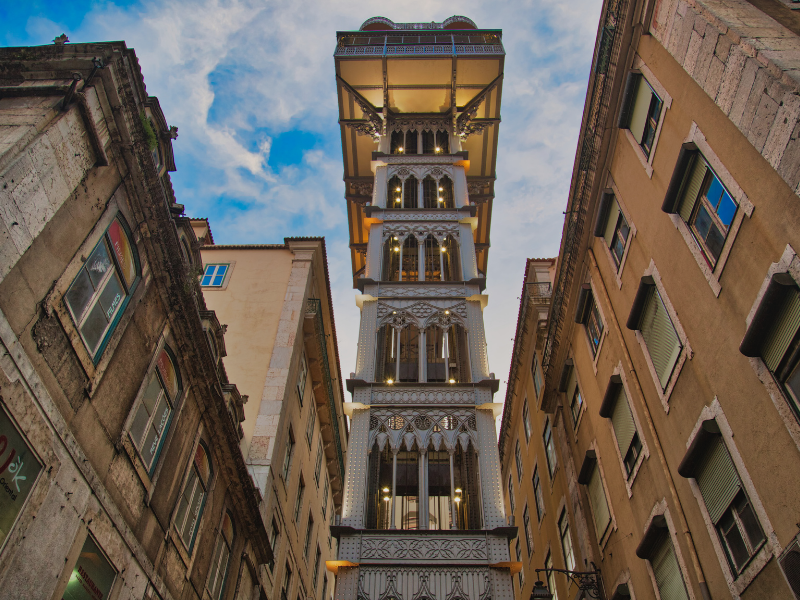
Lisbon is famous for its hills and beautiful lookout points. Therefore, among the most exceptional architectural wonders in Lisbon is Santa Justa Lift. It is also known as Elevador de Santa Justa which serves not only as a practical solution to the steep streets of Lisbon but also offers an amazing view over the city’s scenic beauty.
Santa Justa Lift was constructed by Raoul Mesnier du Ponsard; Portuguese engineer working French roots who completed this structure in 1902. This elevator was built with grandeur and engineering skills alike those used by Gustave Eiffel under whom Mesnier had studied. The lift began running on steam power but switched over to electricity in 1907 thus becoming one major means of public transport within Lisbon.
Being 45 meters high, Santa Justa Lift represents typical neo-Gothic style buildings seen around cities during late 19th century Europe especially England where it was first developed before spreading across other parts of the globe including Portugal. Its frame is made up of iron bars decorated with delicate lace-like pattern known as filigree work which makes it stand out from other structures in its vicinity even though they are taller than themselves thereby attracting attention easily observed by passersby while walking along different streets within this area.
Also, it consists two wooden cabins each capable carrying up to twenty-nine passengers which are connected through spiral staircase leading towards observation deck covered with decorative metal grillwork that overlooks Baixa district, Tagus River and Alfama neighborhood among others.
The part worth mentioning here indeed lies at the very topmost level where we find ourselves looking down upon such places like Bairro Alto –historic quarter–or Carmo Convent –ruined church turned museum–as well Rossio Square –main square surrounded by shops cafes restaurants etc.–everything illuminated below shines brightly against dark backdrop formed due absence light when sun sets behind distant hills giving us breathtaking views over these areas since no words can describe what eyes see but only through personal experience do individuals come face with reality thus understanding true meaning behind those words written above this text.
Nearby Attractions
Once done enjoying Santa Justa Lift, take some time wandering around nearby Baixa district which boasts luxurious squares filled classy shops cafes etcetera. Another place worth visiting would be Rossio Square where there are beautiful fountains surrounded by traditional Portuguese pavement designs as well narrow streets lined houses dating back centuries located within historical Bairro Alto neighborhood offering vibrant nightlife especially in evenings when bars open up their doors welcoming revelers from all walks life interested having fun together.
Ajuda National Palace
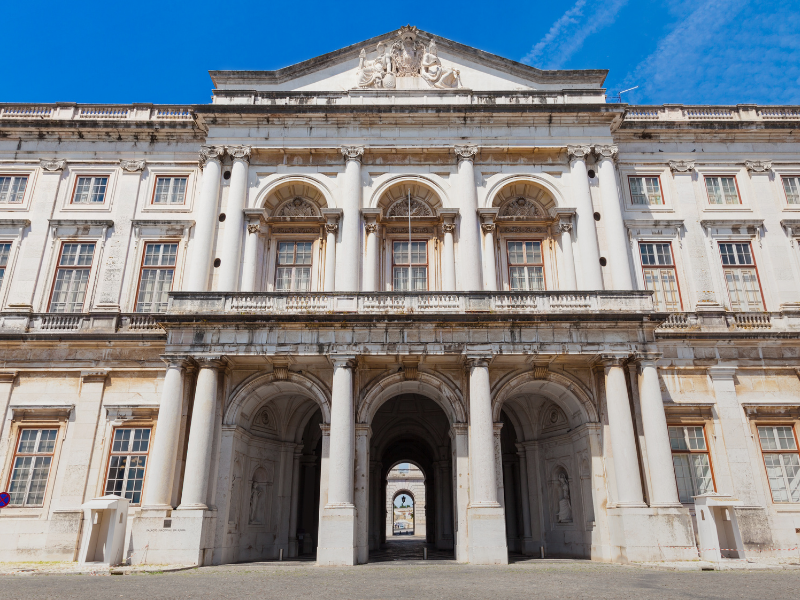
The Ajuda National Palace is found atop a hill in the historical district of Belém and is one of Lisbon’s grandest yet often ignored attractions. Built as a temporary home for the royal family after the great earthquake of 1755, which devastated much of downtown Lisbon, it became a permanent testament to Portugal’s wealth and ambition under the monarchy. Today it functions as a museum, providing visitors with an intriguing glimpse into life among Portuguese royalty during the 19th century.
Though construction on the palace commenced in 1796, many changes were made before it assumed its present appearance. What was originally planned as a wooden structure turned into what was supposed to be one of Europe’s most magnificent palaces. This mix between neoclassicalism and Romanticism – two prevalent architectural styles from that era – can still be seen today even though this building remains unfinished save for some decorative arts pieces that line its walls.
Not only does Ajuda serve as a museum but different cultural happenings such as concerts; exhibitions; academic gatherings etc., take place here too. These events ensure that this marvelous edifice continues playing an active role within Lisbon’s cultural scene thereby linking up yesterday’s history with tomorrow’s realities.
Nearby Attractions
- Botanical Garden (Jardim Botânico) at Ajuda: Right next door lies these beautiful gardens where you can take refuge amongst stunning botanical collections.
- Belém Tower (Torre de Belém) and Jerónimos Monastery (Mosteiro dos Jerónimos): Just short distances away from each other and not far off either are these iconic landmarks which provide further insights into Lisbon’s rich maritime past while serving as must-sees on any itinerary through town.
Carmo Convent
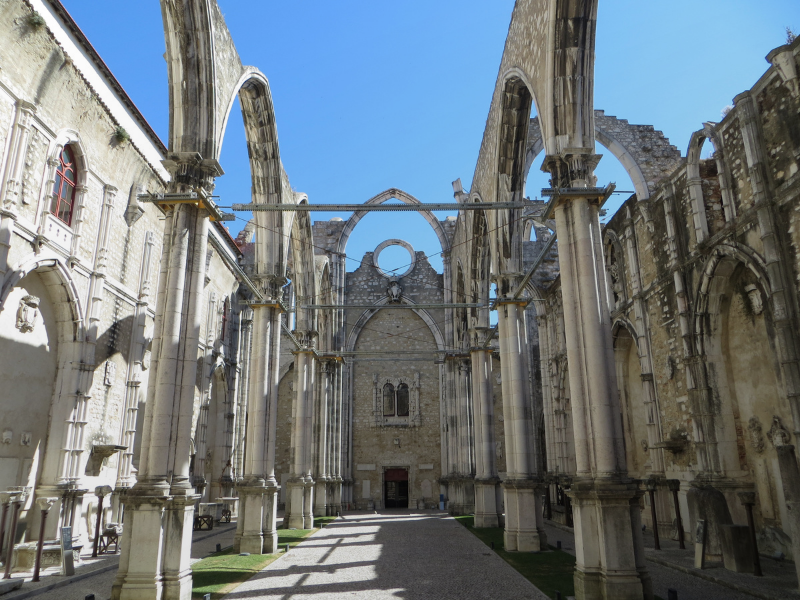
The Carmo Convent (Convento do Carmo) located on top of one of the highest hills in Lisbon is a beautiful ghost that recalls Portugal’s history. It used to be among the most important convents in Lisbon until 1755, when the great earthquake destroyed it beyond repair. Hence, this structure remains as a museum without walls where people can see for themselves its bare bones and feel its significance against the sky.
Nuno Álvares Pereira established the Carmo Convent in 1389 as a residence for members of the Carmelite Order. Until it turned into rubble due to an earthquake that hit Lisbon three centuries later, it thrived as both religious and political centers of power within this city. Rather than reconstructing them however, these ruins were left untouched so they could serve not only as memorials but also as eternal symbols indicating how much resilience Lisbon has got.
Certainly, there are numerous artists; historians and writers who have found inspiration from what is now known simply as ‘Carmo’. Moreover; during summer months especially when nights feature live performances with stars overhead, music events take place within its precincts.
Nearby Attractions
- Santa Justa Lift: This elevator close by affords visitors some unusual views over Lisbon as well as easy access into Baixa district.
- Rossio Square: A short distance away from here lies Rossio square which is always buzzing with activities thereby presenting another opportunity for one to delve deeper into Portuguese historical background while at the same time enjoying vibrant cultural experiences.
Chiado

Chiado, among Bairro Alto and Baixa districts of Lisbon, is considered as one of the most vibrant and sophisticated areas in the city. It merges old-fashioned charm with modern elegance. Chiado has many historic cafés, trendy shops and a lively cultural scene which makes it an excellent base for those looking to experience true Lisboan life.
Since the 19th century, Chiado has been at the heart of intellectual and artistic life in Lisbon. The first modern cafes and theaters were opened here in Portugal, which attracted leading writers, artists and thinkers. This continued until 1988 when much of the area was destroyed by fire; architect Álvaro Siza Vieira led a careful reconstruction that preserved its historical fabric while blending new developments with old buildings.
Highlights
- Livraria Bertrand The oldest running bookstore in the world founded back in 1732 boasts an extensive literature selection and holds regular literary events that attract bookworms from around globe.
- Teatro São Carlos A stunning opera house from the 18th century where one can watch some best classical music performances held anywhere within Portugal.
- Museu Nacional de Arte Contemporânea Situated on Rua Serpa Pinto this museum showcases Portuguese contemporary art ranging from 1850’s up till now.
Shopping & Eating Out
- Fashion Boutiques International designer labels plus unique local stores offering Portuguese crafts & clothing are what make Chiado such heaven for shoppers seeking something different.
- Café A Brasileira Associated with Fernando Pessoa – one Portugal’s greatest poets – this establishment is still visited by tourists as well as residents who come here enjoy traditional coffees pastries alike.
Nearby Attractions
- Santa Justa Lift Old-fashioned way travelling up to higher Largo do Carmo while getting treated breathtaking panoramic views over downtown Lisbon.
- Carmo Convent Ruins gothic church nearby which serve reminder about city’s many historical layers.
Basilica of Estrela
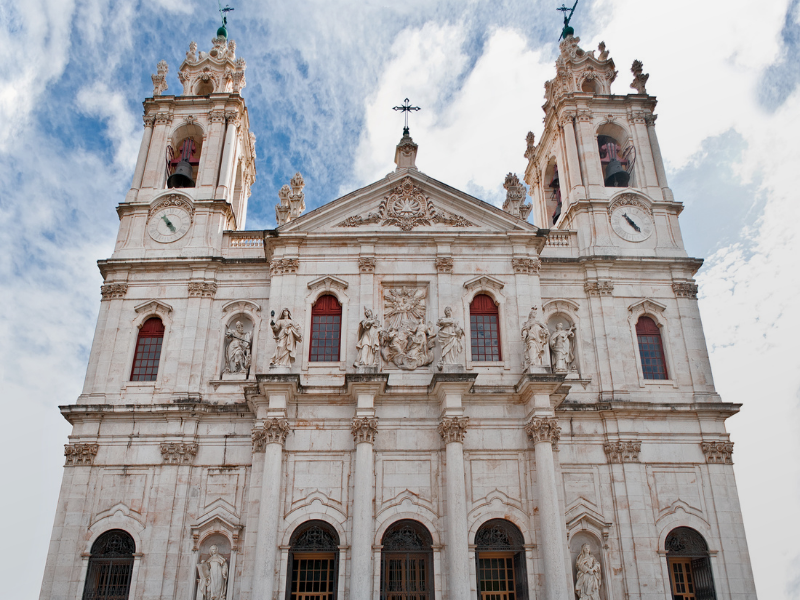
Sitting on the lovely Estrela district of Lisbon, the Basilica of Estrela (Basílica da Estrela) stands as a huge example of Baroque grandeur. Erected in the last 1700s, this basilica is both an important religious place and an architectural treasure with its extravagant design and historical significance being known to draw tourists.
The Queen Maria I of Portugal commissioned The Basilica of Estrela after promising to do so if she gave birth to a healthy child. Built between 1779 and 1790 in honor of her son’s birth – José, Prince of Brazil; it displays characteristics from late baroque to neoclassicism with intricate facades dominating over local skylines through its dome.
Lisbon’s cultural beacon and active worship center is The Basilica of Estrela. For those who want to take part in religious ceremonies it can be quite moving during mass times while also serving as good venue for occasional classical music concerts due its outstanding acoustics.
Nearby Attractions
- Estrela Garden: This beautifully landscaped park is located just across from the basilica making it ideal for taking a leisurely walk or having picnic after your visit.
- Tram 28: One can catch this famous tram service near the basilica which offers scenic ride through some most picturesque neighborhoods found within Lisbon.
Feira da Ladra
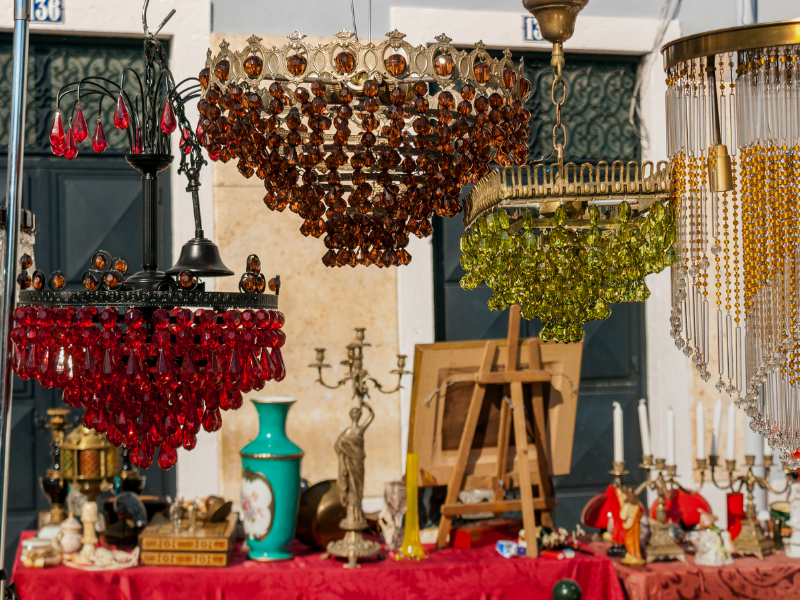
Feira da Ladra, which is often called “Thieves’ Market” in English, is the oldest and most famous flea market in Lisbon. It is located in Alfama, the historical district of the city. The busy market offers a wide range of products such as antiques, handicrafts, books, clothes and oddities. The event takes place every Tuesday and Saturday and provides an opportunity to see local life and buy interesting things for both tourists and residents.
The history of Feira da Ladra goes back to the 12th century – that makes it one of the oldest flea markets on the whole continent. In its earliest days it was a gathering spot for peddlers and thieves who wanted to sell their stolen merchandise there – hence its name. With time this market turned into a legal establishment where people could find various second-hand articles and vintage treasures from all over Portugal.
Nearby Attractions
- National Pantheon: This building is just next door to the market. Many Portuguese celebrities were buried here. You should definitely check out its architecture as well as enjoy panoramic views from its terrace.
- São Vicente de Fora Monastery: Walk a little further from Feira da Ladra to reach this monastery famous for its beautiful azulejos (tiled walls) depicting different historical events and religious scenes at once.
Monsanto Forest Park
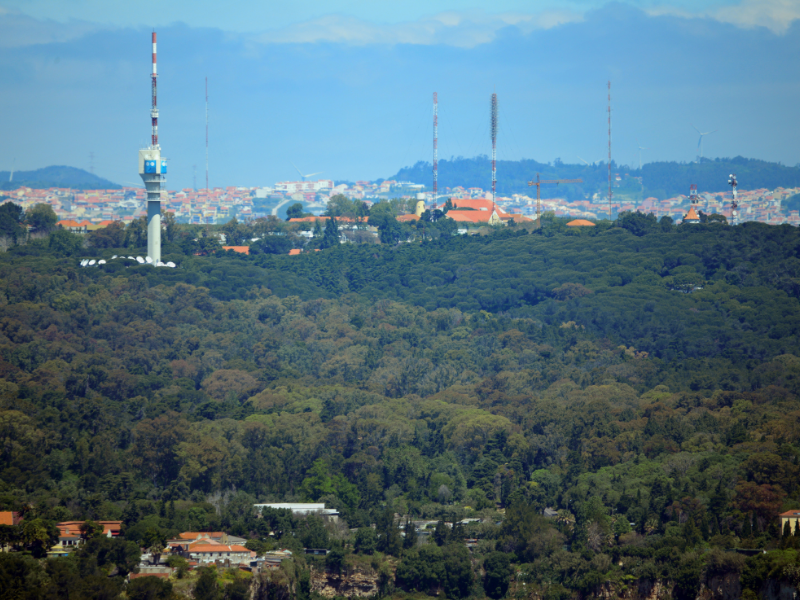
Referred to as the “Lungs of Lisbon”, Monsanto Forest Park is Portugal’s largest green space in its capital. It sprawls for almost 1000 hectares which makes it a vast park that acts as an essential getaway both for residents and tourists offering various outdoor activities against the backdrop of thick woods and panoramic views of the city. If you want a place to hike, cycle, have a picnic or just relax in nature then Monsanto Forest Park should be your next destination.
Monsanto is not only a park but an alive ecosystem too with many things living inside it. The variety of its landscape includes protected areas for wildlife habitats, dense forests as well as well cared-for picnic spots and playgrounds among others. This remarkable diversity of plant species coupled with animal life found within makes this location perfect for lovers of natural environments and families too.
To the people of Lisbon, Monsanto Forest Park occupies a special place in their hearts. In the 1930s it was conceived as part major reforestation scheme aimed at providing the city with some sort green belt but over time has evolved into much loved retreat from urban life where cultural festivals are held, concerts performed outdoors all year round while also acting host to educational programmes that help connect communities with nature.
Nearby Attractions
- Lisbon Zoo: Located on the outskirts of Monsanto, this is another great family attraction in itself being home to numerous animal species plus interactive exhibits designed for children too.
- Ajuda Botanical Garden: Just a short drive away from Monsanto lies Ajuda which boasts rich history through its plants collection making it provide visitors with serene natural environment unlike any other.
Parque das Nações (Park of the Nations)
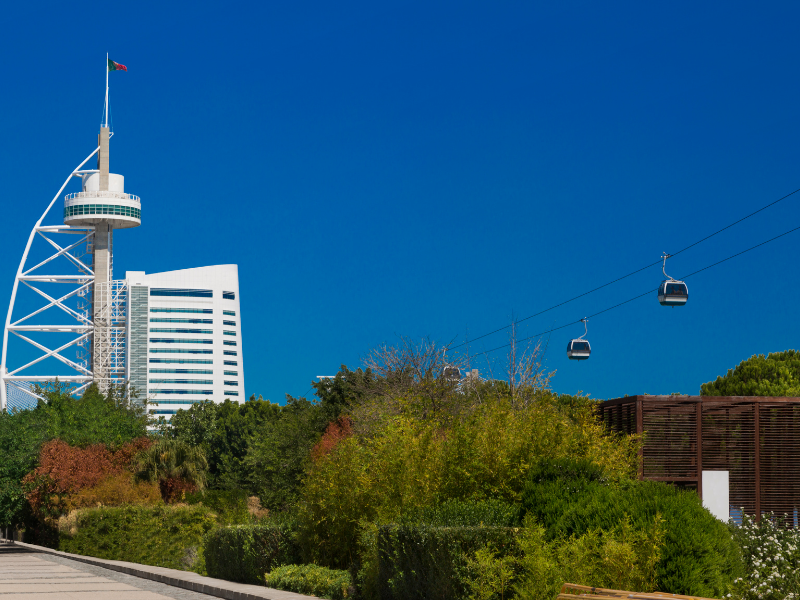
Parque das Nações, or Park of Nations, testifies to the modernity and creativity of Lisbon. Built for the Expo ’98 World Exposition, this waterfront area has become a lively cultural, recreational and business center. The contemporary architectural designs, vast public spaces and multiple attractions in it offer an experience one cannot miss while in Lisbon.
The park was constructed on the site of a former industrial area along the banks of the Tagus River. The 1998 World’s Fair with its theme “The Oceans, a Heritage for the Future” pushed forward development in this part of town resulting into many iconic buildings and public spaces being created. Today Parque das Nações is a living district where past meets future seamlessly.
Structural Wonders And Places Of Interest
Vasco da Gama Bridge: Parque das Nações boasts one of Europe’s most eye-catching structures – Vasco da Gama Bridge. With a length that exceeds 17 kilometers, it is not only Portugal’s longest bridge but also an emblem that shows off their engineering skills. This bridge provides an amazing view over the rest of District especially at sunrise or sunset time.
Oceanarium Lisbon: Oceanário de Lisboa is among world largest aquariums housed indoors. It presents different marine species which include sharks, manta rays as well as penguins among others too numerous to mention here; thus making this place very attractive not only for children but also adults who can find themselves mesmerized by looking at all those creatures swimming around inside tanks filled with water taken directly from Atlantic Ocean – there’s another great reason why you should visit it next time when travelling through Europe! The central tank simulating global ocean looks particularly captivating indeed!
Pavilhão do Conhecimento: A science museum that allows visitors to touch and play with its exhibits regarding scientific phenomena; suitable mainly (though not exclusively) for families wishing their children could learn more about how things work while having fun at the same time.
Gare do Oriente: A transportation centre built by famous architect Santiago Calatrava; considered as one of his best achievements ever made worldwide because it perfectly reflects what modern day architecture should look like according to many experts within this field. It is therefore no wonder why so many people admire such buildings when passing by them every day on their way home or going somewhere else altogether.
Cable Car: This type cableway provides unordinary view over some parts of town served including riverside area where Parque das Nações located. During trip passengers can enjoy panoramic view over Tagus River with Vasco da Gama Bridge in background so don’t miss this opportunity for taking pictures too.
Church of Saint Roch

Located in the lively Bairro Alto neighborhood, the Church of Saint Roch (Igreja de São Roque) is among the most impressive religious sites in Lisbon. Its baroque interior is stunningly beautiful and historically important, making this Jesuit church a peaceful place that will leave visitors feeling inspired.
Constructed towards the end of the sixteenth century, The Church of Saint Roch was one of the earliest Jesuit churches globally. It was also one of few structures able to withstand much damage from an earthquake in 1755, meaning it has retained its original appearance unlike many other buildings in Lisbon. This church is named after St.Roch who is considered patron saint against plagues; therefore it has served as both spiritual center and gathering point for locals over hundreds years.
At first glance, you might think that The Church of Saint Roch does not differ greatly from other churches with its simple façade and classical lines. But once you step inside… wow! The interior is decorated entirely in baroque style – every inch covered by ornate designs which are enough to take your breath away.
Nearby Attractions
When you’re finished exploring all there is within The Church of Saint Roch take some time to wander around outside and throughout different parts such as Bairro Alto – an area renowned for being particularly vibrant thanks mainly due narrow streets filled mostly packed with historic buildings cafes shops and bars where people gather day or night either coffee glass wine hand while soaking up history around them; Miradouro de São Pedro de Alcântara which offers breath taking views over whole city.
National Coach Museum
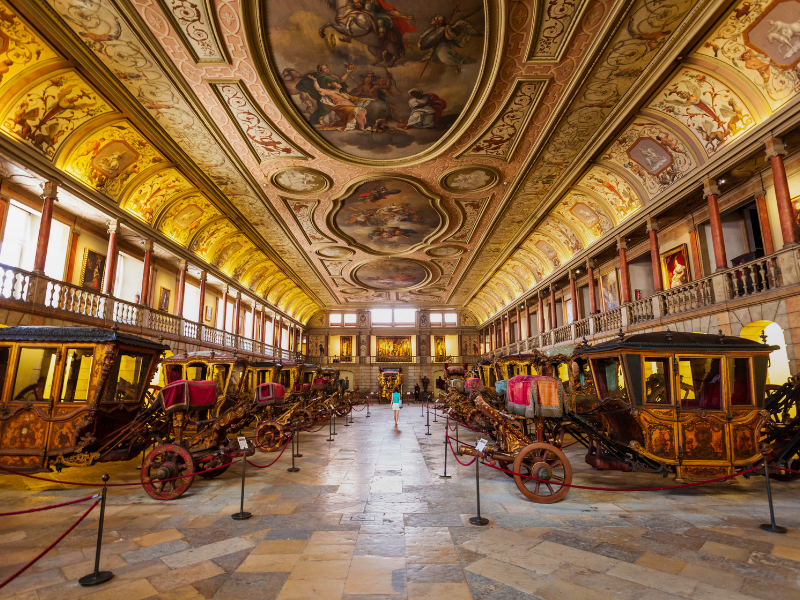
The Museu Nacional dos Coches in Lisbon, also known as the National Coach Museum, is one of the most interesting and original places in the city. Located in the Royal Riding Hall of Belém, which was magnificently restored for this purpose, it exhibits an impressive collection of royal carriages that will tell you a lot about the country’s ostentatiousness as well as its kings’ means of transport.
Queen Amélia of Orléans and Braganza opened The Museu Nacional dos Coches in 1905 to preserve these magnificent chariots reflecting the glory of Portuguese monarchy. Today it is considered one among world’s leading museums with such collections attracting visitors from every corner on earth.
Paulo Mendes da Rocha – brazilian architect created a modern annex building while maintaining historical integrity within Royal Riding Hall where different ages meet side by side giving us an unforgettable experience through space design alone or both together at once so if someone wants something they can find here even past present future all in one place only thing needed being time itself should stand still forevermore.
Nearby Attractions
Once you have finished exploring The Museu Nacional dos Coches take some time out to see around Belém area nearby which has got lots for history lovers. There are multiple cultural landmarks including Belem Tower and Jeronimos Monastery both being within walkable distance providing more insights into Portugal´s past however do not miss trying Pastéis de Belém (traditional custard tarts) from their famous bakery.



